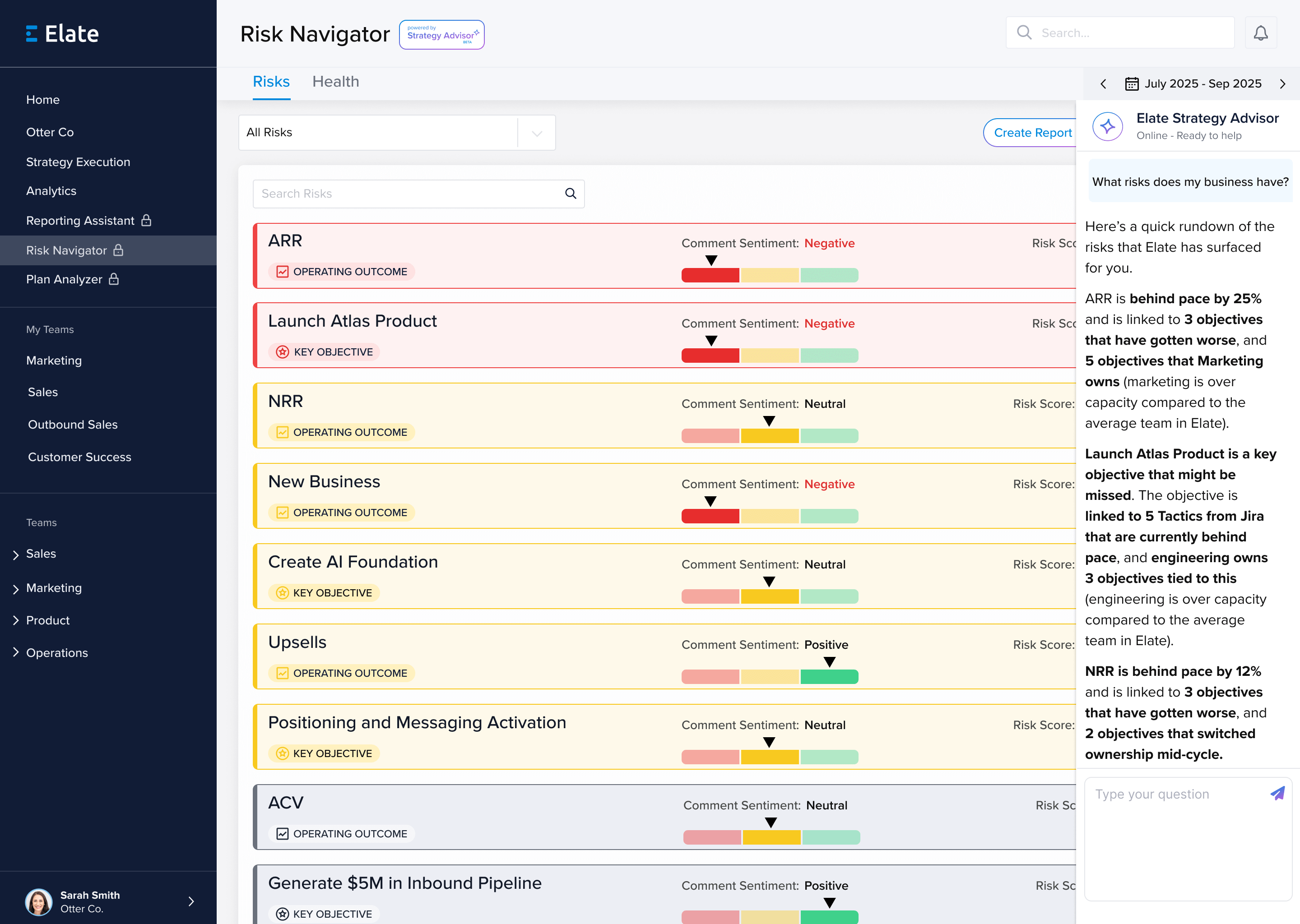For today’s leading companies, strategic planning can serve as a competitive advantage to how they think about growth. Now more than ever, it’s essential that companies have a clear operating framework to help optimize for efficiency and alignment. Without a clear-cut strategy and direction that’s been agreed upon by leadership and communicated to the company, it’s easy to lose focus on priorities and instead find team’s bogged down with urgent, but non-essential initiatives. But how do you actually stay focused on what matters most to the business and the goals you’ve set out to achieve?
For starters, it requires your team to view strategic planning as more than just a process to ‘check-the-box’. Strategic planning is evolving to be a more dynamic and real-time process that allows companies to frequently evaluate your operations to ensure they are as efficient and goal-oriented as possible. Building a strategic plan gives you the ability to set goals and generate success while understanding the needs of your company and customers. Several models of strategic planning help you achieve different results, but ultimately guide you in improving your company’s operations and products or services.
At Elate, we built our strategic planning solution from the pain we felt firsthand as former strategy and operations leaders. Our platform was created to help strategy and operations leaders build a strategic plan all in one easy-to-use solution that gives you the power to drive accountability and create visibility. In this post, we will discuss what are the various types of strategic planning and how to implement them. You’ll be on your way to building a better plan for your business in no time.
What Is Strategic Planning?
Strategic planning is when a company determines a strategy or direction, deciding how to allocate resources to reach a goal while staying competitive in their industry. Typically, to discover the fundamental variables driving their present performance. A business’s strategic plan consists of its:
- Mission of the company that drives success and customer engagement
- Vision for the strategic plan and the ultimate reason for changing
- Values of the business and the plan itself to ensure integrity
- Long-term goals that the business wants to achieve through the plan
- Action procedures to achieve the strategic plan goals.
What Are the 5 Planning Techniques?
Strategic planning techniques allow your business to assess and develop plans to improve organizational functions. But “Which is the best planning technique?” is often a difficult question to answer because the technique your business uses depends on the information needed to plan effective strategies. With this in mind, we have laid out the top five strategic planning techniques and tools to help you take the next steps in your business planning.
Balanced Scorecard
Developed by Robert Kaplan and David Norton, the balanced scorecard is a comprehensive look at a business’s objectives and operations. As they open their article, “What you measure is what you get.” In other words, you’ll only see improvements in the processes that you are paying attention to. To ensure that an organization's strategic objectives are realized, they are measured, monitored, and modified as needed. Customers, internal business operations, development and innovation, and finances are all elements of the scorecard that add up to four distinct reference points for goal-setting and performance evaluation. When developing a balanced scorecard, you should consider those points by asking:
- Customer perspective: How do our customers understand and view our business?
- Internal perspective: What can we do better for our mission and outdo our competitors?
- Innovation and learning perspective: Can we continue to improve and create value?
- Financial perspective: What is our potential profitability for our stakeholders?
Developing a strategic plan based on these four categories may assist you in creating more introspective and specific goals for your business. According to Kaplan and Norton, a balanced scorecard “forc[es] senior managers to consider all the important operational measures together” by “let[ting] them see whether improvement in one area may have been achieved at the expense of another.” As the name suggests, it’s all about finding a balance that allows you to achieve all of your business goals.
SWOT Analysis
A SWOT analysis is one of the more thorough strategic tools used to analyze a business’s competitive situation. This method can help you identify areas where your business can grow and maximize potential by assessing the strengths, weaknesses, opportunities, and threats your business might encounter. A SWOT analysis is used to offer an assessment of a company, project, or sector based on facts and data.
Because of the focus on the positive and negative aspects of your organization, you can assess the best plan of action. According to Hubspot, “a SWOT analysis allows you to make unbiased evaluations on your business or brand, market positioning, a new project or initiative, and a specific campaign or channel.” To build a SWOT plan, you need to answer productive questions like:
- Strengths: What advantages do you have over competitors? What expertise and experience do we have?
- Weaknesses: What skills can we improve? Do we need to invest in assets like technology or gain funding?
- Opportunities: Is your business model or project meeting the needs of the growing market? Will any new regulations or requirements benefit you?
- Threats: What issues might you face internally with teams or departments? Is there competition for the resources needed to complete your project?
SWOT analysis may be helpful at the start of a project or after your team has encountered a snag. Here are a few examples of when a SWOT analysis would be useful:
- Expanding your business into a new market you’ve not invested in before.
- Redesigning your website to identify needs for improvement and engagement.
- Developing a new business idea like companies, products, or services.
- Investing in new opportunities to broaden your business’s reach.
- Partnering with other businesses to examine compatibility.
You'll be in a much better position to take meaningful action if you have a good awareness of your company's strengths and weaknesses, as well as the threats and opportunities in your market. Determining areas for development, establishing precise performance objectives, and building an action plan to stay ahead of the competition may be difficult without a SWOT analysis.
Objectives and Key Results (OKRs)
OKRs can be an intuitive and simple strategic plan framework to help reach important goals. OKRs are made by determining three to five objectives that you want to achieve in your business and then three to five key results for each of those objectives. This will allow you to develop reference points for your metrics to ensure you reach the goals you’ve set. For many companies, you can choose to measure based on % attainment or on a scale on a 0 - 1 scale where 1 equals 100%. For example, if your business’s click-through rate on a social media ad post with a goal of 1000 unique visitors and you only achieve 750, your key result is a 0.75.
At Elate, one of the most common challenges we see with OKRs is companies looking to overcomplicate the process from the onset, or potentially worse, copy and paste another company’s OKR framework. The reality is that much of the beauty of OKRs comes from the high-level structure that can be tailored to your business.
OKRs have the advantage of being very adjustable and easy to measure due to the normalized scale. Teams should ideally aim for roughly 70% success rates on results. Consistent results of 100% might indicate goals that aren’t ambitious enough.
PEST Model
The PEST or PESTLE strategic planning models categorize direct or indirect factors that influence your business’s customers, suppliers, and competitors. They are broken down as political, economic, social, and technological (as well as legal and environmental) market forces. Each of these external factors has a definite impact on businesses and should be explored to see what impact they have on your business. Breaking down the PESTLE model should lead you to answer the following questions:
- Political: What is the country's political status and how does it affect the industry?
- Economic: What economic factors are the most common?
- Social: What is the importance of culture in the market and what elements impact it?
- Technological: What technology breakthroughs are most likely to disrupt the market structure?
- Legal: Is there any present industry law, and if so, could it be changed?
- Environmental: What concerns are there for the environment within the industry?
Determining how these factors influence your business will allow you to understand the greater impact of society and where your business fits within it. PESTLE can be used in combination with a SWOT analysis to compare the strengths and weaknesses determined by SWOT. This provides a much more rounded look at what is needed for change within a business.
Porter’s Five-Forces Model
Porter's Five Forces were developed by Michael Porter in the late 1970s and is an important strategic planning framework model. The Five Forces is a model used to assess how competitive a business is within its industry. This model explains why different industries may be profitable. Porter states in his article, “The collective strength of the forces may be painfully apparent to all the [competitors]; but to cope with them, the strategist must…analyze the sources of each.” The five forces Porter discusses are:
- Threat of new entrants or potential of new competition within the industry.
- Intensity of rivalry among existing firms or competition already within the industry.
- Threat of substitute products or services or what other products will rival your product.
- Bargaining power of customers or how much influence a customer has in numbers.
- Bargaining power of suppliers or how much influence a supplier has against competitors.
Of course, the way your industry operates dictates the effectiveness of this model. Understanding the factors affecting your industry can help you extract more relevant information for your business.
What Are Steps in Strategic Planning?
Developing a strategic planning framework using one of the methods above will help drive alignment across your business, and bring together vision with execution. However, you’ll need to take steps to get there. But what is the most important step in strategic planning? Ultimately the most important step you can take is developing the plan itself, but you should follow the five steps of planning to ensure you create the most effective plan for your business.
- Understand and establish your strategic position to determine your objectives and how you will achieve them.
- Prioritize your goals in order of importance to better understand your needs.
- Create a strategic plan based on the goals you’ve laid out using one of the several types of strategic planning.
- Implement and manage your strategy by communicating with stakeholders and team members and evaluating key performance indicators (KPIs).
- Review and adjust the plan monthly, quarterly, or annually to ensure your goals are met within the timeline.
Start Your Strategic Plan Today
Building a strategic plan takes a lot of time and resources. If you’re struggling to get the ball rolling, there is an easy solution! Elate is the leading platform for SaaS companies to communicate their vision, create alignment, and track performance. We understand the importance of planning techniques and give you the tools to implement your strategy seamlessly and effectively. You can create clear goals, drive alignment, and take control of communication to remain transparent and maintain focus. Visit our website today and you can set up Elate in just a few minutes.











